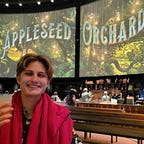The Threat of War on Ukrainian Culture
How does an organization whose purpose is preserving culture, respond to a war that threatens their work and effort?
Kristina Lew answers this question.
Lew, president of the Foundation to Preserve Ukraine’s Sacral Arts, has conducted several civic education programs in Ukraine and authored two books studying churches in the country, but her most notable work is the foundation. The Foundation to Preserve Ukraine’s Sacral Arts, or FTPUSA for short, is a non-profit that works solely on preserving old Ukrainian churches, religious icons, and additionally supports traditional craftsmen in Ukraine. Many tserkvas, or wooden churches have been worn down by the passage of time with some of Ukraine’s oldest tserkvas being 500 years old. These structures represent the country’s culture and many of them are made from wood found in Ukraine’s Carpathian Mountain range, so it is not surprising that the country has over 2,500 tserkvas. In fact, eight of them are on UNESCO’s World Heritage List. This is why Ukraine’s architecture is unique — Ukraine has the largest number of wooden churches in the world and many of them reflect the communities in which these structures are located. The wooden churches require increased preservation efforts, particularly now, amid the war.
Since February 24, 2022, when the Russian invasion broke out in Ukraine, as many as 180 churches and sacred structures have been destroyed. 60 of them are on UNESCO’S heritage protection list. In Kharkiv, Ukraine, Russian attackers hit many landmarks, most notably, the Freedom Square, a monument made during the Soviet constructivist era which later became a symbol for the country’s independence in 1991.
During this war, Lew and FTPUSA have helped colleagues in Ukraine that assisted restoration projects in the past. Lew and the Foundation were able to provide their colleagues with seed money for their efforts in preserving culture. Because of Lew and the foundation’s seed money, her colleagues in Ukraine have founded the Center to Rescue Cultural Heritage. The center has been able to preserve materials from museums and libraries, namely abstract art, religious art, and historical collections. They have worked with museums across Europe who shipped packing materials such as bubble wrap, scotch tape, and various other materials needed for protecting precious art. These materials were shipped to Warsaw where they were then packed onto rail cars and brought into Lviv.
When materials were emptied in Lviv, many families who were fleeing Ukraine would get onto these rail cars and evacuate out West. In Lviv, groups of preservationists stuffed packing materials into vans, which were then transported to institutions in Chernihiv, Dnipro, Kharkiv and Zaporizhzhia. Without a doubt, the Foundation and the Center’s work was crucial in this effort.
Lew additionally highlights Ukraine’s struggle as a nation and mentions how Ukraine has always fought to maintain its national identity throughout history. When it was a part of the Soviet Union, it was robbed of nationalism as well as religion and since its independence in 1991, she continues, the country has had to work hard to define its national character. Her overall goal from her efforts is to preserve the architecture that distinguishes Ukrainian culture and history, because art strengthens Ukrainian identity. Lew has seen this goal met endlessly through the help people have been providing during the war. She sees that everyone is doing their best to help and believes that if everyone continues to do their part, even if it is small, it can go a long way to aiding the most vulnerable.
If you want to hear more about her work amid the war, click here for the full audio interview:
Special thanks to Khristina Lew for providing the interview and Derrick Laurion for providing the photos!
